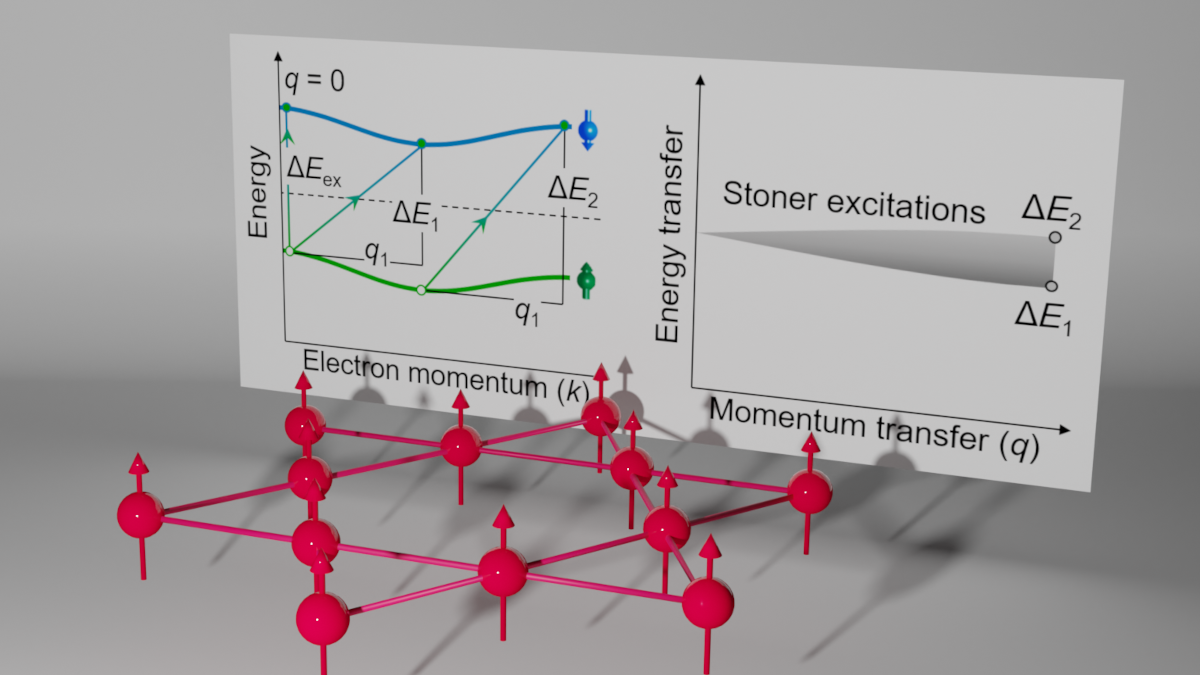Topological materials (including topological insulators, Dirac and Weyl semimetals and skyrmions) are a hot topic in science at the moment. A gold rush of sorts is underway, to discover and investigate the exotic physical properties of these materials, which could be the key that unlocks next-generation energy-efficient electronic devices and quantum computing. In some materials, geometrical confinement of electrons can give rise to electronic correlations that manifest as dispersionless 'flat' bands. These flat bands are of particular interest, as they can result in unconventional ferromagnetic and transport behaviour. However, there have been few characterisations of flat bands and their magnetism. In work recently published in Nature Communications, scientists from Diamond's I21 beamline used resonant inelastic X-ray scattering (RIXS) to investigate the ferromagnetic Kagome semimetal Co3Sn2S2, reporting the first observation of flat-band Stoner excitations in this material. Their results also demonstrate that RIXS can clarify the magnon-Stoner interactions in itinerant correlated flat band systems.
Kagome is a traditional Japanese basketry pattern where triangles surround hexagons. The same arrangement occurs in the crystal structure of some materials and can constrain the movement of electrons. The suppression of the electronic kinetic energy gives rise to enhanced electronic interactions and a band that is flat in momentum space (Fig.1). Flat band systems can exhibit diverse many-body phenomena, such as unconventional superconductivity, Mott-insulator transition and the fractional quantum Hall effect.

In an ordinary ferromagnetic metal, the large dispersion of the spin-polarised electronic bands makes the spin excitations (known as Stoner excitations) broad and featureless.
Dr Kejin Zhou, principal beamline scientist on I21, said;
We wanted to explore the nature of Stoner excitations in Weyl semimetals, where non-dispersive spin-polarised bands span the system. Co3Sn2S2 is one of the few ferromagnetic Kagome systems expected to have flat bands. As a Weyl semimetal, Co3Sn2S2 also offers the potential for tuning its topological properties via magnetism. Although angle-resolved photoemission spectroscopy (ARPES) has recently identified occupied flat bands in several materials, that technique cannot detect spin excitations, which is why we used RIXS.
Using high energy-resolution Co L3-edge resonant inelastic X-ray scattering, the I21 team found well-defined and nearly non-dispersive Stoner excitations.
Dr Zhou explained;
These well-defined excitations were in stark contrast to the broad, featureless Stoner continuum of ordinary ferromagnetic metals. The resemblance of the experimental results to the spin susceptibility calculation, as well as the thermal evolution of the excitations, confirm the localised and well-defined Stoner excitations as a unique signature of correlated electronic flat bands in Co3Sn2S2.
The researchers also investigated the Kagomé metal CoSn, which has extensive flat bands. However, CoSn is a paramagnetic metal rather than a ferromagnet. Here, RIXS showed no evidence of Stoner excitations, demonstrating that the technique is highly sensitive to magnetic spin-polarised electronic bands. Dr Zhou concluded;
This is good news to experimentalists, theorists and material designers alike. It means that RIXS can be used to study the band-induced spin excitations with energy and momentum resolution in magnetic topological materials, in complement to ARPES and scanning tunnelling spectroscopy (STS). Understanding these exotic behaviours is the first step towards using them in next-generation electronics.
To find out more about the I21 beamline or discuss potential applications, please contact Principal Beamline Scientist Kejin Zhou: [email protected].
Nag A et al. Correlation driven near-flat band Stoner excitations in a Kagome magnet. Nature Communications 13.1: 1-7 (2022). DOI:10.1038/s41467-022-34933-y.
Diamond Light Source is the UK's national synchrotron science facility, located at the Harwell Science and Innovation Campus in Oxfordshire.
Copyright © 2022 Diamond Light Source
Diamond Light Source Ltd
Diamond House
Harwell Science & Innovation Campus
Didcot
Oxfordshire
OX11 0DE
Diamond Light Source® and the Diamond logo are registered trademarks of Diamond Light Source Ltd
Registered in England and Wales at Diamond House, Harwell Science and Innovation Campus, Didcot, Oxfordshire, OX11 0DE, United Kingdom. Company number: 4375679. VAT number: 287 461 957. Economic Operators Registration and Identification (EORI) number: GB287461957003.